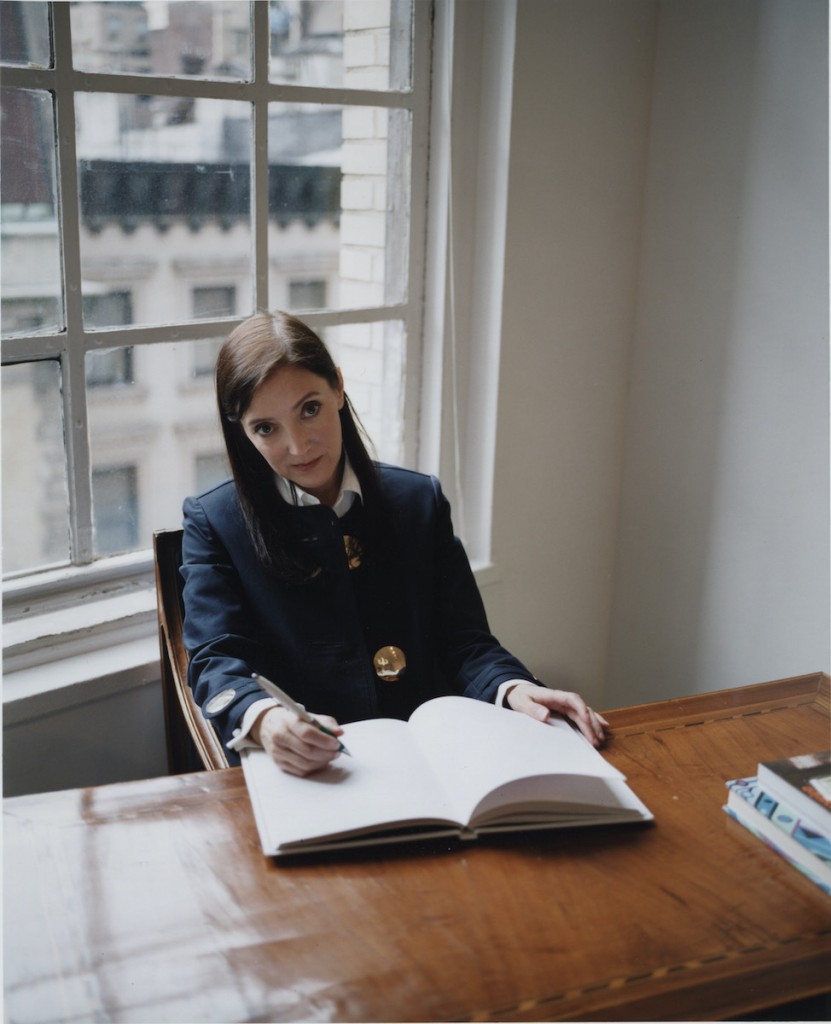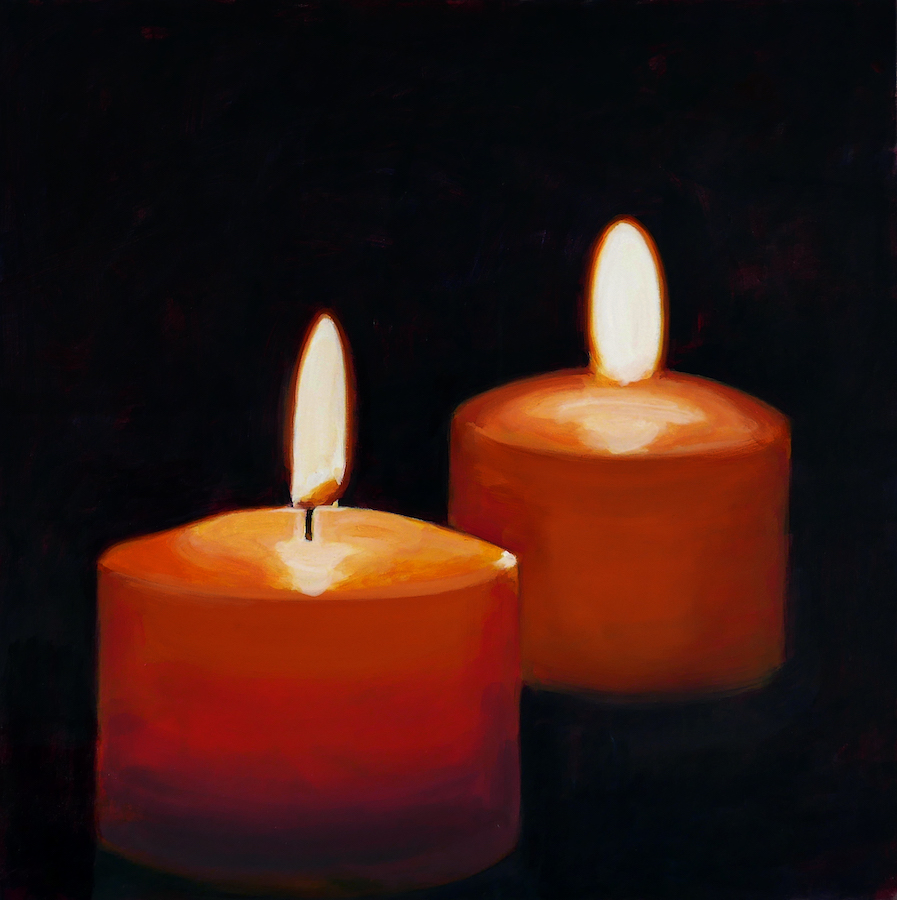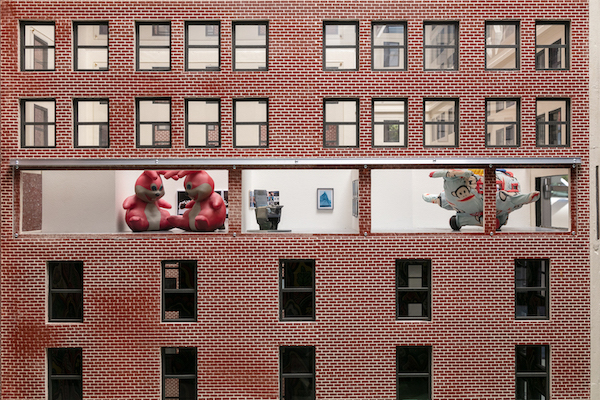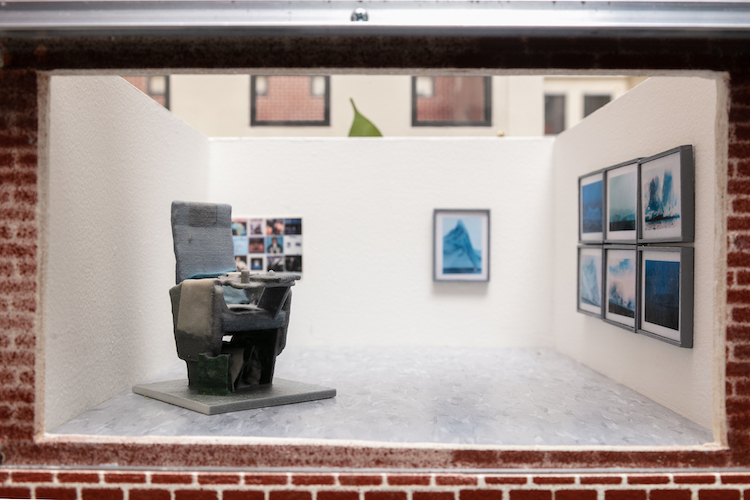Established in 1998 by siblings Devon Dikeou and Pany Dikeou, the Dikeou Collection is a contemporary art collection in Downtown Denver that is free and open to the public. Operating as an extension of New York publication zingmagazine, the Dikeou Collection features work of over 40 international artists. An artist herself, Devon Dikeou is also the founder, editor, and publisher of zingmagazine, as well as an art collector. Her interest in the platform of exchange among collector, artist, viewing context—museum, collection, gallery, magazine—and viewer engendered her artistic practice, zingmagazine, and the formation of the Dikeou Collection.
Devon shared with LARRY’S LIST how she started collecting art, how she has commingled all her various roles together, what painting was her first love in art, what motivated her to set up publicly accessible spaces for the collection, and why price transparency is healthy in the art world.

Collecting
What made you want to start collecting art? What is the main motivation behind your collecting?
There is very specific moment when my three practices—as an artist, editor/publisher of zingmagazine and collector all meshed. In 1985, I was an intern at Tibor De Nagy Gallery in New York and spent a good portion of my time organizing and sorting old Artforums in the basement of the Gallery (really a disused ladies bathroom between floors at 41 West 57th St). And what an education… paging through that gospel of contemporary art… At that time, there wasn’t really a textbook about current art, only analog access to research tools, very different from today. I depended on that diet of Artforum and it proved to be quite fruitful. Besides reviews and articles, Artforum published artists’ projects… and a Lucas Samaras project called “Market” piqued my interest. As I remember, there were three double-page spreads: the first featured a neo-abstract expressionist B & W skeleton and underneath the word, “Artist”; the second DPS, zoomed into the head of the skeleton and featured the word “Dealer” below; and the third focused even closer on the skull, detailing the mouth in color, and was accompanied by the word “Collector”. (At least that’s how I remember it, it turns out the “Artist” DPS was in fact the “Critic”). All these positions as presented in the Samaras project delineated the roles in the art world and really was the genesis of my practice as an artist, editor/publisher, and collector. So in that vein, my first artwork, titled “What’s Love Got to Do with It: From Sculpture”, addressed these positions. The influence of all those old Artforum projects, as well as the long history of publishing in the De Nagy circle, and my next job working for the curatorial team at Collins & Milazzo, influenced my founding and publishing of zingmagazine, (1995 Ongoing, 25 issues to date) which publishes artists projects on 2-16 pages of free content. zingmagazine’s unique presence and unusual format provides a glimpse behind the proverbial “art curtain” and has made the segue into art collecting a natural step. In 1998, with my brother Pany Dikeou, we formalized collecting with the Dikeou Collection, a collection of contemporary artwork that is open to the public (Wednesday-Friday 11:00 -5:00).
When did you fall in love with a piece of art? What was it?
My first love was a Richard Estes painting “Drugstore” at a traveling exhibition at Denver Art Museum in the 60s. Candy was the real love of my childhood life, and in retrospect my response to the Estes feels like some kind of Lacanian exercise. The drugstore so unbelievably and realistically rendered was beyond what a photograph could ever be, and even exceeded the real thing in desirability. Funny I have held that piece dearly in my mind’s eye and tried mightily to find it on the internet. I haven’t, but I did find an exquisite series of revolving doors, which became a series I have been working on as an artist since the 80s…
For my brother and compatriot in the Collection, I think one memorable excursion to the Walker in 87 was the game changer. Together we visited the museum during a trip to Minneapolis for the World Series between the Twins and the St Louis Cardinals. I introduced him to Cindy Sherman’s “Untitled Film Stills”, Jenny Holzer’s “Truisms” displayed on LED columns, and a James Turrell wall installation—what an introduction.


What is your focus regarding the artists in your collection? Are you more interested in emerging or renowned artists, international or American artists?
Our general focus is in contemporary art with artists with whom we have forged a relationship, but we are not limited to that. We feel that it is very important to not just choose single works by artists, but rather we are interested in collecting significant work by the artists we are interested in, in whatever their medium. We collect so that work collected can be understood in depth. If the artist’s practice is drawing or photography, we try to acquire a complete series. Lisa Kereszi’s series “Drinking” appeared in issue 9 of zingmagazine and all images from that published series became part of the Collection. If the artist is an installation artist, we collect the entire installation. Sometimes we are lucky, feeling/seeing the work in prescient moment, which was the case with Wade Guyton’s “Untitled, The Room Moved, the Way Blocked,” an installation that we acquired very quickly after his Graduate Show at Hunter, and was specifically made to fit a room in the Collection, replicating the Hunter installation. We are particularly not afraid of collecting work that may be hard to display, archive… I’m thinking of Johannes Van der Beek and Anicka Yi for example. Johannes’s work is made up of the New York Times Newspaper and is a miniature Utopian City, titled “Newspaper Ruined” and is a Calvino like “Invisible City” full of twists and turns on a table top plateau. Anicka’s installation, “L’Haine” is a series of Benneton-like sweaters with deep fried flower bouquets growing, sprouting from the neck of each sweater—a contemporary Arcimboldo in a way.

Johnson
Is there any particular type of art that has consistently attracted you, or anything that unites all the works you have acquired?
We try not to limit our collecting impulses. No specific themes or mediums… we try to see the work as they are, but also with a multitude of contexts and readings. Of course, sharing the work with other institutions is something we relish. Being an artist in residence at Artpace in San Antonio allowed us to forge a relationship with Artpace, and we collaborated showing a number of different installations throughout their entire Campus and the usual exhibition platform, the Hudson Show Room. Nils Folke Anderson’s “Untitled” was exhibited in the Sculpture Studio among the welding and casting equipment, Momoyo Torimitsu’s, “Somehow I Don’t Feel Comfortable” in the conference room, Wade Guyton on the roof. Margaret Lee’s three “Zebras (Huh What)” and Simon Periton’s “Anarchy Doily”, in the actual Show Room.


What were the latest artworks you purchased?
After having said we do not collect with themes in mind oddly, our most recent acquisitions conjure “fire and ice”—a series of candle paintings by Walter Robinson, and an ice ashtray by Lizzi Bougatsos.
And like each new group of acquisitions, these works will be installed in the next series of installations in both of The Collection sites.


How many artworks do you own? Where do you display your collection?
We have the work of 45 artists, and their work is displayed in Downtown Denver in two locations, both free and open to the public.
Our idea is based more on a public presence rather than one of private consumption/enjoyment. Our presentation comes from the in-between perspective of an artist, that of publisher/editor, the collaboration practice of collecting, and of course, all three as they interface with the public. The public arm is as significant as the act of collecting, and sharing it has been part important from the beginning. The original public space opened in 2003 in a series of rooms in a downtown Office Building, the Colorado Building (1893-1935). The rooms that house the work are office suites and remain close to their original condition, cleaned up with a glass office door. Each artist’s work occupies a single room or is shared jointly between two artists. Following the Judd tradition, the work has remained in place since its inception for public view, so that viewer, and especially repeat viewers, may experience the work over time. Our second space, The Dikeou Collection Pop Up, is on East Colfax also downtown, adjacent to the Capital, and about a seven-minute drive from the Colorado Building. In the abandoned Jerry’s Record Shop, it lays claim to a vinyl collection numbering close to 15,000 records. Displayed in the record shop are works by Lizzi Bougatsos, Sarah Staton’s Supastore Superstars (Simon Bill, Ellen Cantor, Tracey Emin, Anya Gallacio, Georgie Hopton, Gary Hume, Simon Periton, Sarah Staton, Tomato, Tim Noble & Sue Webster) Devon Dikeou, Rainer Ganahl, Anicka Yi.
Alongside these fully realized projects in both spaces each artist has a zingmagazine project and the issue(s) in which their work appears are integrated within the Collections as a resource. The Dikeou Collection in collaboration with zingmagazine has a series titled “zing Projection Drawings,” featuring wall murals, the first of which is displayed outside in the alley of the Pop Up presenting the work of Olav Westphalen. (Other forthcoming Projections: Christian Schumann, Jovi Schnell, Ester Partegas, Juan Gomez, Luis Macias). Another sister project relic is “evel machines”—artist-designed information kiosks, including a Christian Schumann kiosk with touch screen access to digital media, etc.

What is your most treasured artwork?
The treasure is the collection itself.
How important is it for you to meet the artists who created the artwork?
As I’ve been an artist in the New York art world, the work we collect has very much been that of my peer group. So it’s more of an organic relationship than a goal. We generally meet or know the artists as a result of engaging or working with them, of publishing them in zingmagazine, showing or exhibiting with them, or just general chilling…
The Dikeou Collection
What is your motivation behind setting up a publicly accessible space?
As artist’s project, a collaboration, an extension of zingmagazine, the motivation behind public accessibility comes from these perspectives. As the positions co-mingle between artist, publisher/editor, and collector, so do the definitions. The public aspect is as necessary as the artists, the publication that engendered the collection, and the artist’s perspective, it’s the conjunction that joins the sentences, so to speak. . . . and that public is intrinsic to all these practices. And one of the most public aspects is web presence. Years ago in the mid 90s when zingmagazine began (1995) we were one of the first magazines to have a website. Originally Nina Borgmann at Artnet was behind that gesture and it was only gesture in 1996, and then our website was more formalized by Kenny Goldsmith, who created the design and navigation, all of this hosted by thing.net, Wolfgang Staehle’s ongoing project. At Dikeou Collection director, Hayley Richardson archives all the works in the Collection, keeps a blog about all the artists in the Collection and their goings on internationally, nationally and even locally, and we have a platform, ART-CO for local artists to post images of their work as a resource art database for other artists, curators, creatives to find, meet, research, mingle. Accessibility in this case, our digital footprint, is the conjunction that joins the public to the art, the artists, the viewing community, the critical audience.
What are your visions for the Collection and the space in the upcoming years?
We see the Collection as a public tool and resource and truly try to make the Collection and the work accessible… to be generous with what is already generous in spirit: the work of these artists. In that vein, programing has and will be part of our ongoing presence. We have showcased Artist Talks, Poetry Readings, Jazz Series, and through our extensive Vinyl Library and DJ appearances, developed quite a following. zingmagazine even has an Airstream… that shows up all over the place spreading the zing word and the secret of the zing essence.

The Art World
As an artist/publisher/editor/collector, how do you merge art collecting with your own art practice?
Merging, being in between, commingling… these activities happen naturally and have become quintessence, almost the subject of some or much of the work as an artist-editor/publisher-collector, and an installation I made for NADA Miami in 2013 called “Pay What You Wish, But You Must Pay Something” addresses this. I asked approximately 80 American Museums to provide plans for replication of their donation boxes, which I would show at the fair, an in-between space that already is a platform where all these positions are on full display or in practice. About 20% responded positively and the installation exists as a series of 21 replicated museum donation boxes displayed at the fair prompting fairgoers to drop donations in the boxes, all donations were tallied and then given to the institutions of name. The formal quality of the appearance of the boxes recalls the strident tenets of minimalism with a wink, the utilitarian conquest of the donor ask, and yet also nods to performance aspects of relational aesthetics. Finally, the installation literally breaks down all the aspects of in-between in terms of authorship, critical discourse, and collecting bases that you ask about and is so much a part of my practice.
What’s your art-world pet peeve?
My pet peeve is having to ask prices at commercial gallery exhibitions. Galleries not publicly posting prices has long been debated and the source of even some enforcement issues in the late 80s, early 90s when the city clamped down on galleries making it so that any passersby could have price access. I think it’s healthy for this kind of information to be publicly available, for the general public, the cognoscenti and especially to art students… it takes away some of the mystique and dulls the sticker shock… there is a piece in Harper’s Monthly in the Readings Section that features a letter exchange the Whitney Museum engaged in the 80s about why they paid $1,000,000.00 for “Three Flags”. The correspondence goes back and forth between the letter writer, who continually states their query is in earnest, and the Museum which is not so forthcoming.
But Harper’s is even less forthcoming than the Whitney, choosing not to publish the enclosure the Whitney sent the letter writer, and rather only publishes the back and forth. More information doesn’t hurt anyone.

What inspires you the most in the art world?
The art. The best part is the feeling that only art gives, doesn’t matter what it is, where it is, and you can find it anywhere, travel for it, sure, seek it out, yes, happen upon it, doesn’t matter. So it’s not a person, it’s not even the thing itself, not the object, collected or not, rather it’s the magic that art unleashes.
What are you especially excited about in regard to art in 2022?
Among the pieces that form my practice and exemplify my tripartite interest of collecting editing/publishing and making work is “The Dikeou Collection: Tiny Town”. Outside Denver near the famed Rock and Roll Amphitheater, Red Rocks, is small tourist destination whose main audience is children. That place, Tiny Town is a “settlement” of replicated small, tiny buildings, homes and businesses, etc placed in a setting that includes a miniature train and seasonally hosts young’uns in its park like setting. The historic Colorado Building where the Dikeou Collection houses the Collection, in its turn of the century architectural gem, has been painstakingly recreated and the Collection rooms are at the height of a 6 six year old, and the viewable rooms exhibit several of the Dikeou Collection artists in miniature. Currently it is situated in the lobby of the Colorado Building, but will be moved to the Tiny Town site and installed permanently at the end of Mid-Career Smear. The reinstall of the Dikeou Collection plus an expansion with new artists and their installations will follow the Tiny Town placement.

Related: Dikeou Collection
Instagram: @devondikeou, @dikeoucollection, @zingmagazine
A selection of artists Devon and Pany collect:
Anicka Yi
Lizzi Bougatsos
Margaret Lee
Wade Guyton
Walter Robinson
By Ricko Leung





